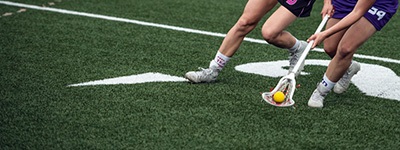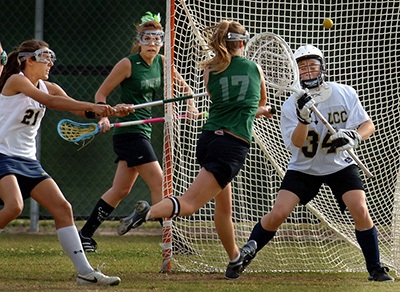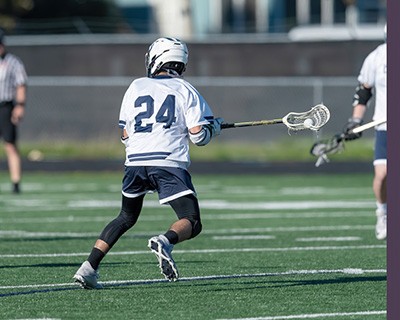Whether you're brand new to lacrosse or a seasoned vet, some basic lacrosse stick check rules need to be followed for your team to be successful.
But before we jump into the details of knowing what's allowed on the field during play, let's break down how essential it is for everyone involved in the sport of lacrosse — coaches, players, referees — to enforce stick check regulation both by understanding and following them (as well as performing checks throughout gameplay).
This article will provide a comprehensive overview of the most relevant stick check rules and what makes them illegal so you can remain knowledgeable when you step onto the field.
Read on to find out more!
More...
Take Away Key Points:
Lacrosse checking rules
Every player on the lacrosse field must adhere to specific regulations when it comes to checking.
These rules vary depending on the level or type of competition, but in general, all players must follow these basic rules:
1. No body-checking allowed
Contact must be limited to the stick and ball.
Body-checking is strictly prohibited and can result in penalties or ejection from the game. Body checking is not allowed in lacrosse as it can result in serious injury to the players.
Valid body checks consist of broken-down, controlled contact with an open hand without the threat of injury or excessive force.
Closed fists and contact above the shoulders are strictly prohibited, which reduces the risks associated with the sport and allows for a safe playing environment.

2. No slashing allowed
Slashing is defined as contact with a stick or body that endangers the player's safety. Any use of excessive force or reckless contact against another player can be considered slashing and thus will result in a technical foul.
In addition, players may not use their sticks to check an opponent's body or equipment, nor can they extend their arms beyond the shoulders of their opponents while attempting to control or dislodge the ball.
3. Stay within legal limits
All contact with an opposing player should be reasonable and limited to "poking" or "brushing" with a stick only. It is against the rules for any player to swing a stick or make contact above shoulder height.
By following these basic rules of lacrosse checking, you can ensure that everyone enjoys a fun, safe game.
Illegal stick check rules
Checking can be illegal in lacrosse if it is done with the intent to cause harm or injury. Any attempt to interfere, snatch, or steal an opponent's stick is deemed illegal and will result in a penalty.
In addition, the defensive player must keep their body away from the attacking player when attempting a legal check and use only their crosse.
Here is a close look at an illegal stick check:
1. Illegal body checks
Body checking is integral to lacrosse, but it must be done legally. Illegal body checks are a severe penalty and result in a personal foul for the offender. The most common deemed illegal body checks are leading with the elbow and hitting from behind. In addition, helmet-to-helmet and helmet-to-body contact are also illegal.
The most important thing is to remember that it is illegal to snatch, interfere with, or steal another player's stick during a game.
A defensive player must maintain their body away from the attacking player when attempting a legal contact check and only use their lacrosse stick.
Any attempt to cause harm or injury through an illegal and avoidable body check is strictly prohibited and will result in significant penalties ranging from personal fouls to suspension.
Additionally, players should always avoid physical contact of any kind, as it can lead to more serious consequences and potential injury.
2. Free hand checks
While free-hand checks are generally legal, they should never be used excessively or with excessive force.
If a player performs a free-hand check that is too aggressive or causes harm to another player, it will be considered an illegal check and result in penalties for the offending player's team.
Typical forms of illegal free-hand checking include:
- Striking an opponent's stick with your hands instead of pushing it away
- Poking or jabbing at opponents with your fingers
- Intentionally making contact with another player rather than just their stick
- Pulling on an opponent's stick instead of pushing it away
3. Cross stick checking
Cross checking is a form of contact in lacrosse that involves using the stick to push or press against an opponent's body. While this tactic can be used as a defensive move, it can also cause serious injury if done recklessly. As such, certain cross checks are illegal and result in penalties for the offending player.
There are three main types of illegal cross checking:
- Reaching across with two hands on your stick to check the other player.
- Pushing down onto an opponent's body with your stick while you possess the ball. Body check is allowed above the belt only.
- Pulling down on an opponent's jersey or shirt with your stick while defending them.
Women's lacrosse stick rules for checking

Women's lacrosse requires a certain level of finesse when using a stick to check an opponent.
A legal check is used to knock the ball out of an opponent's possession without making contact with the body. In contrast, an illegal check can lead to severe injuries and penalties for the offending player.
A critical difference between men's and women's lacrosse is that girls play lacrosse with little to no physical contact. Therefore, players must understand the proper technique and be adequately trained to execute a legal and effective stick check.
In women's lacrosse, stick checking is not introduced until the players reach a certain age. Before this, any contact with the opponent's stick will result in a foul.
Typically, younger girl athletes don't possess the same skills and ball-handling abilities as older players, making turnovers more likely caused by factors other than stick checks.
However, as girls get older and their strength, speed, and maturity improves, attackers will be less likely to lose control of the entire ball without a legal check being applied. Stick-checking becomes an essential defensive move for good defenders who have mastered the technique and can use it effectively to keep possession of the ball.
It is important to remember that any incorrect form or execution can cause serious injury, which should be avoided at all costs. Therefore, control and precision are essential when executing a stick check!
Lacrosse illegal stick penalty
Illegal stick penalties are an essential part of lacrosse and should be taken seriously by players. When an illegal stick is used, the offending player can be issued a yellow card, a warning for the first offense, or a red card, which requires the player to leave the game for the remainder of the match.
Common causes of illegal stick penalties include:
- Playing with an illegal length or weight of the stick. (Check out our lacrosse stick sizing guide)
- Using a narrow lacrosse head (which is wider than 6 inches).
- Pull strings are not allowed in the lacrosse pocket, as they provide an unfair advantage to the player. All pockets need to have only one sidewall string.
- Having sharp edges on your stick.
- Pushing or hooking your opponent's stick with yours.
- Checking your opponent in any way (cross-checking, slashing, etc.).
It's important to remember that these lacrosse rules exist to ensure fair play and reduce potential injuries in lacrosse. Therefore, if you are unsure if your actions could result in a penalty, it's best to err on caution and play conservatively!
How to practice legal stick check
Stick checking is an integral part of lacrosse and a vital skill for anyone looking to pivot quickly and control the flow of a game.
Here are some key points to keep in mind when stick-checking in lacrosse.
Is my lacrosse stick legal?

Lacrosse sticks must comply with the specific rules and regulations set by U.S. Lacrosse and NCAA rules to be legal for competition use and youth lacrosse.
A stick must be constructed from approved materials, properly strung according to the outline, and include an approved complete shooting string that does not exceed 1 ¼ inches at its widest point.
- The lacrosse head must measure between 6 and 10 inches wide, 2 ½ to 3 ½ inches deep, and have a sidewall height of 4 ½ to 5 ½ inches, measured from the base of the pocket. Players need to oblige the US Lacrosse stick length rules and NFHS lacrosse stick rules.
- The material used in construction must also meet the standards established by U.S. Lacrosse which includes all lacrosse heads manufactured out of metal or plastic having a finished surface that is smooth enough so as not to cause injury to players or affect playability. The lacrosse sticks should also have no manufactured end cap.
- The stick's shaft must also meet specific requirements, including being made of aluminum or any other approved material and measuring no more than 72 inches long. In addition, it must have a diameter within 0 - 0.5125 inches at its base and up to 0 - 0.7475 inches at its top end near the lacrosse head attachment point, depending on whether it's a women's or men's version (men's sticks are slightly larger).
- Finally, the lacrosse pocket must feature laces crossed over at least three times to be considered a legal pocket under U.S Lacrosse regulations. However, players need to have an appropriate pocket depth. Shooting strings should not be lower than four inches from the lacrosse head. Refs often find a pull string used to control the pocket depth in the deepest point, which can often result in a penalty.
FAQs
What is an illegal stick check in lacrosse?
An illegal stick check in lacrosse is any contact made with the opponent's body that was not initiated by the ball. This includes pushing, tripping, and hitting the other player's stick or body with one's stick. Body check is only allowed below the shoulders of the opponent and above the waist.
These types of contact are illegal and can result in penalties for the offending player.
Can you check with your stick in lacrosse?
Yes, stick checking is allowed in lacrosse, provided it is done according to the lacrosse rules and laws. When checking an opponent's stick with one's own, the defender must ensure the stick does not make contact with any part of the offensive player's body.
What are the rules for checking in lacrosse?
Players must adhere to the following lacrosse rules when stick-checking:
- Check only with the lacrosse head of the stick, not its shaft or butt-end.
- Contact must be limited to the stick, and there must be no contact with any part of an opponent's body or equipment.
- Reach-checks and poke-checks (tapping an opponent's stick with one's own) are permissible as long as they are done responsibly.
- Checks should always be done safely to minimize the potential for injury.
- Long poles cannot be used for checking due to their larger surface area, creating the potential for dangerous contact.
Do you have to check lacrosse sticks?
Yes, it is a player's responsibility to check their opponent's stick for any illegal materials or deformities.
Stick checking has become an important part of the game to help protect players from potential illegal sticks and injuries.
How do you practice stick checks in lacrosse?
Here are a few tips for practicing stick checking:
- Move quickly but stay aware of your surroundings.
- Check safely by using only the lacrosse head of the stick and not its butt-end or shaft.
- Always reach-check or poke-check responsibly with minimal contact.
- Use long poles sparingly as they pose a higher risk of injury.
What checks are illegal in lacrosse?
In lacrosse, some stick checks are illegal. These include:
- Cross-checking: using more than one lacrosse head of the stick to hit an opponent's body or stick.
- Checking with intent to injure: using excessive force while checking an opponent's stick.
- Poking or poking checking: thrusting the end of the goalie's stick at the opposition. Only a goalie can use a goalie stick.
- Holding an opponent's crosse with the hand or foot.
- Using a helmet, armguard, rib protector, or any other piece of equipment as a shield when initiating contact with the ball carrier or defender's crosse.
Conclusion
Stick-checking can be an effective and safe way to stop opponents from advancing or obstructing the flow of a game. However, players must be mindful of the lacrosse stick check rules and regulations, practice safe techniques and avoid illegal moves such as cross-checking or poking.
With careful attention and practice, stick checking has the potential to be an important part of every lacrosse player's game.
